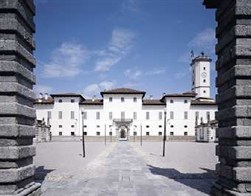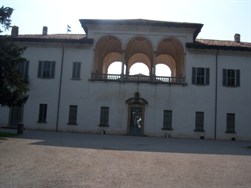Palazzo Arese Borromeo in Cesano Maderno
 One of the most important families in the history of the Duchy of Milan in the Baroque period was undoubtedly the Arese familyThe Arese family is one of the most important families in the history of Milan. Originating in the village of the same name on the outskirts of the city, they began their economic-social climb under the Visconti and Sforza families, but reached their peak of power in the sixteenth and seventeenth centuries, when they were able to build a strong bond with the representatives of Spanish power in the duchy. Most of the Arese were nobili togati, “nobles of the robe”, well placed in the state administration and justice.. Count Bartolomeo III AreseThe eldest son of Giulio I, Count Bartolomeo III Arese (1610-1674) brought the palace of Cesano Maderno to completion on which work had begun in 1654, under his father. Like the latter, Bartolomeo III was elected President of the Senate in 1660, the highest administrative office to which a native of the duchy could aspire. An Honorary Regent of the Council of Italy, he was a skilled politician and a man of great culture. Thanks to his marriage with Lucrezia Omodei he united himself to one of the richest families of Milan., a powerful benefactor and patron of the arts and a leading figure in politics and administration in Milan, was responsible for the construction, completed between 1660 and 1670, of the Palazzo Arese Borromeo of Cesano MadernoCesano Maderno is a town of the province of Monza and Brianza. In the Early Modern period it was a fief of the Arese and then of Borromeo Arese.. Although the project was initiated decades earlier by his father, Giulio AreseGiulio I Arese (1575-1627) was the son of Marco Antonio and father of Bartolomeo III. In 1619 he became President of the Senate of Milan, and acquired the title of Count of Castel Lambro. He started the building project of the family palace in Cesano Maderno., Bartolomeo III modeled it according to his taste, making it a magnificent example of a country house and equipping it also with a beautiful garden.
One of the most important families in the history of the Duchy of Milan in the Baroque period was undoubtedly the Arese familyThe Arese family is one of the most important families in the history of Milan. Originating in the village of the same name on the outskirts of the city, they began their economic-social climb under the Visconti and Sforza families, but reached their peak of power in the sixteenth and seventeenth centuries, when they were able to build a strong bond with the representatives of Spanish power in the duchy. Most of the Arese were nobili togati, “nobles of the robe”, well placed in the state administration and justice.. Count Bartolomeo III AreseThe eldest son of Giulio I, Count Bartolomeo III Arese (1610-1674) brought the palace of Cesano Maderno to completion on which work had begun in 1654, under his father. Like the latter, Bartolomeo III was elected President of the Senate in 1660, the highest administrative office to which a native of the duchy could aspire. An Honorary Regent of the Council of Italy, he was a skilled politician and a man of great culture. Thanks to his marriage with Lucrezia Omodei he united himself to one of the richest families of Milan., a powerful benefactor and patron of the arts and a leading figure in politics and administration in Milan, was responsible for the construction, completed between 1660 and 1670, of the Palazzo Arese Borromeo of Cesano MadernoCesano Maderno is a town of the province of Monza and Brianza. In the Early Modern period it was a fief of the Arese and then of Borromeo Arese.. Although the project was initiated decades earlier by his father, Giulio AreseGiulio I Arese (1575-1627) was the son of Marco Antonio and father of Bartolomeo III. In 1619 he became President of the Senate of Milan, and acquired the title of Count of Castel Lambro. He started the building project of the family palace in Cesano Maderno., Bartolomeo III modeled it according to his taste, making it a magnificent example of a country house and equipping it also with a beautiful garden.
The building is in the late Baroque Lombard styleThe late Baroque Lombard style is a style of painting and architecture, also known as Barocchetto lombardo, close to Rococo and which flourished in England in the late seventeenth century and the first half of the following century., quadrangular, simple and elegant in form. At the center is a courtyard with a loggiaThe loggia is an architectural element, part of open building, supported by columns and pillars and generally equipped with a balustrade. It may be accessible or have a merely decorative function. on the side opposite the entrance. The main façade (photo 1) is sober, the central portal is between Doric lesenes and surmounted by an eighteenth-century wrought-iron balcony. In front of this façade is the Piazza ad EsedraThe exedra is a semicircular and uncovered architectural space, often surrounded by porticos or columns., in the past the scene of feasts, spectacles and performances, which is accessed along a long straight avenue, now Corso Libertà . Characteristic elements of the structure are the chapel, located in the north wing, and the hexagonal tower (built on the ruins of a medieval tower) in the southern wing.
 The eastern façade of the building is certainly the most famous and the most characteristic of the entire structure. The niches containing busts of the Caesars and the decorations around doors and windows distinguish it. The aforementioned loggia with three double bays, stands out, which, on one side, faces the inner courtyard and the other the magnificent garden. Characteristic is also the obvious tilt to one side of the whole structure, which, however, is not uncommon in the palaces of the time.
The eastern façade of the building is certainly the most famous and the most characteristic of the entire structure. The niches containing busts of the Caesars and the decorations around doors and windows distinguish it. The aforementioned loggia with three double bays, stands out, which, on one side, faces the inner courtyard and the other the magnificent garden. Characteristic is also the obvious tilt to one side of the whole structure, which, however, is not uncommon in the palaces of the time.
The interior of the palace is divided into districts. If the ground floor was reserved for the utilities, in the remaining sectors there were reception and meeting rooms, study rooms and the library, servants’ rooms, and, of course, the private apartments of Count Arese and his family. Boasting a remarkable art collection and library, the palace conserves frescoes of various masters of Classicism in Milan, among with the so-called Boscherecce, scenes in nature or in the wild, often with mythological characters. In the Hall of Honour, or Hall of the Fasti Romani, the rich decoration depicts an audience of people from different social backgrounds (ladies and gentlemen, but also waiters and beggars) who, from a balustrade, which is also painted, observed the feasts and banquets organized in the salon. The lower part of the walls is embellished with scenes from the history of Rome and with images of statues of kings and emperors.
